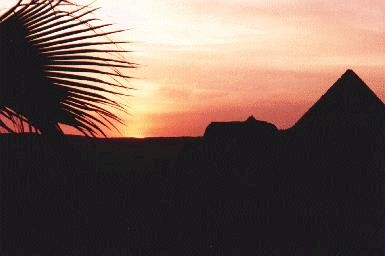

Guardian's Egypt
Late Breaking News
(All new articles are copyrighted by their respective sources)
28 February 1998
Web posted at: 20:41 SAT, Johannesburg time (18:41 GMT)
ABU SIR, Egypt, Feb 27 (Reuters) - Czech archaeologists on Friday opened the basalt sarcophagus of a Pharaonic priest who had remained undisturbed since his burial over 2,500 years ago.
About 30 dignitaries and journalists crammed into the 13 sq metre (140 sq feet) underground tomb of Iufaa which was discovered by the Czech mission in 1995.
Twenty-eight metres (92 feet) above them, almost 120 diplomats and archaeologists waited in the desert around the Abu Sir pyramids for a glimpse of the coffin which dates back to 525 BC.
"This tomb has been undisturbed by robbers. The fact it was found in situ is unique," Czech Egyptologist Miroslav Barta told reporters at the site, some 20 km (12 miles) west of Cairo.
"This is a great discovery but it is not as important as the amount of information we will find about the ancient lives of the Egyptians," he added.
Inside the tomb shaft, labourers dusted off the four-tonne basalt coffin lid with its benign-looking depiction of Iufaa before wrapping it in chains and lifting it.
Spectators gasped as they saw the decorated wooden lining of the tomb and the fragile wooden box containing Iufaa's mummy. Workers removed the canopic jars, furniture and wealth of pottery around the tomb before it was opened.
"This is very important because it reveals the secrets of a man who was also the controller of the Pharaonic palace," Zahi Hawas, director of the Giza pyramids plateau, told Reuters.
Barta said Iufaa's tomb was the first to be discovered intact after British archaeologist Howard Carter opened Pharaoh Tutankhamen's gold-filled burial chamber in 1923.
Archaeologists said that while no gold or jewels were found in the priest's tomb, the richly inscribed sarcophagus and the limestone walls were invaluable for Egyptologists.
"The tomb provides information about when the Persians were in Egypt, something we don't know much about," Barta said.
Archaeologists said Iufaa probably practised under 26th dynasty Pharaoh Ankhkaenre Psamtik who was dethroned by Persian ruler Cambyses. "The tomb is in an isolated cemetery of 12 others who probably cooperated with the Persians," Hawas said.
Barta said the Pharaonic cults had many Persian followers and Iufaa's tomb showed he was highly regarded.
Most of the original limestone walls of the tomb no longer exist and the Czech mission built a dome above the sarcophagus to protect it from the crumbling rock it was cut into.
"There is no gold in this tomb but the amazing thing is that it was found intact. It is like looking at the unknown. The sands of Egypt always reveal secrets," Hawas said.
Copyright 1998 Reuters Limited. All rights reserved.